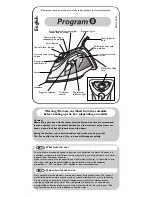
17
9.
When you have finished, leave the iron to
cool before storing.
12. IRONING TIPS
11 AUTOMATIC SWITCH-OFF
When selecting the temperature, follow
the instructions printed on the label of the
garment to be ironed. If the garment does
not have a label, use the table below:
TEMPERATURE TABLE
The automatic switch-off device is activated
when the iron has not been moved for
approximately 8 minutes in standing
position, or 30 seconds in horizontal
position. The auto off indicator light (13)
flashes and a beep sounds. As soon as the
iron is moved, the device is deactivated
and the iron switches on again.
If you have any doubts about the
composition of the fabric, always begin
ironing at a low temperature on a
concealed part of the garment and slowly
increase the temperature setting, taking
care not to spoil the fabric, until all the
creases have disappeared.
•
Fabrics such as velvet, wool, etc., and
items such as gloves and bags, can be
revamped by slowly passing the iron a
few inches above them with the steam
option on.
•
Carpets can be made to look like new
and furniture marks eliminated by lightly
steaming the flattened area and then
brushing gently.
•
Divide the items to be ironed into
temperature groups and begin with
those that require the lowest setting.
•
Silken fabrics should be ironed inside
out.
•
Wool, cotton and fine linen should be
steam ironed inside out. Alternatively,
you can iron them the right way round
covering them first with a thin piece of
cloth to avoid "shiny" results. Starched
fabrics need to be dampened slightly.
For best results, iron white and light
coloured garments the right way round,
and dark and embroidered items inside
out.
•
Linen fabrics should be steam ironed.
Use the spray option liberally and iron
dark garments inside out to avoid
"shiny" results. Iron lapels the right way
round for best results.
Synthetic fibres
Silk
Wool
Cotton
Linen
Fabric
Temperature
13. INFORMATION FOR THE
CORRECT DISPOSAL OF ELECTRICAL
AND ELECTRONIC APPLIANCES
At the end of its working
life, the product must not be
disposed of as urban waste.
It must be taken to a special
local authority differentiated
waste collection centre or
to a dealer providing this
service. Disposing of a household appliance
separately avoids possible negative
consequences for the environment and
health deriving from inappropriate disposal
and enables the constituent materials to be
recovered to obtain significant savings in
energy and resources.
To remind you that you must collaborate
with a selective collection scheme, the
symbol shown appears on the product
warning you not to dispose of it in
traditional refuse containers.
For further information, contact your local
authority or the shop where you bought the
product.
















































